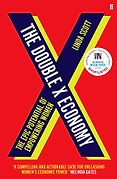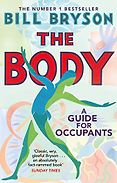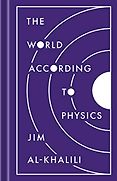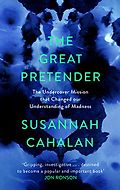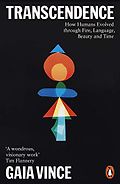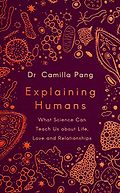Before we get to the science books you’ve chosen for the Royal Society as the best of 2020, you’re a poet as well as a scientist: how do those two areas of work go together for you?
Good science, like good art, is creative. In science, the visual arts, and in poetry you identify a problem and investigate it. All of them involve observation, enquiry and diligence, and finding a solution — a best possible truth — and then communicating this. I find the clarity and brevity that poetry requires has come back to my scientific writing.
What were you and your fellow judges looking for in the books that were put forward for the 2020 Royal Society Insight Investment Science Book Prize?
It was interesting talking to the staff at the Royal Society right at the beginning of this, when I got 170 or so books delivered to my house at the beginning of lockdown! The Royal Society has certain guidelines: does the book communicate science in an exciting and interesting way? Will it appeal to a non-specialised adult audience? Is it well-written and clear? Is there too much technical detail? Is there too little science?
That pile of 170 or so books was so beautiful and so varied in content. It spanned a very broad range of disciplines. It was my job to choose 50 from the 170. The panel came on board to cut that down to the final six and the winner. We chose books that make science a meeting place for all, through whatever means, so long as they inspire, excite, challenge and open up new ways of thinking.
Let’s turn to the six books that you selected for this year’s shortlist, starting with The Double X Economy by Linda Scott. This is a book about economics, politics and justice that has also been shortlisted for the Financial Times’s business book prize. Why is it a science book?
We did discuss that among the judges and with the Royal Society staff, but it is clear that economics is entirely within the scope of the prize. Last year’s winner, Invisible Women by Caroline Criado Perez, was about the gender gap. The Double X Economy is a rigorous presentation and analysis of data to show that women are excluded at great cost to society as a whole. It’s an important, relevant and timely topic. Linda Scott has an enormous amount of hands-on experience working with communities in developing countries, researching women’s economic exclusion in various fora, and advising at the highest international levels.
The book contrasts the villages of Africa and the slums of Asia right through to boardrooms in the US and other rich countries. It’s a very thorough book with lots of graphs and charts to illustrate key points, but they’re presented in a very simplified, accessible way so the reader can take them or leave them depending on how much detail they want to go into.
“The Royal Society has certain guidelines: does the book communicate science in an exciting and interesting way? Will it appeal to a non-specialised adult audience?”
The argument is that there is a distinctive pattern of economic inequality that is relevant to the female population of every nation. The book highlights barriers such as property ownership, capital, credit and access to markets. It discusses constraints imposed on women including limited mobility, reproductive vulnerability and threats of violence.
It’s a manifesto, a call to arms. The thesis is that if this systematic inequality could be redressed by promoting women as equal participants in the economy, then this would dramatically improve social, financial and economic conditions for everyone. In the final part of the book, there are suggestions for specific steps as to how this could be achieved. It is quite revelatory in that it challenges that whole genre of books on how women can become more effective in the workplace by building their confidence and developing strategies to ‘fit in’.
Please tell us about the next book that made the 2020 Royal Society science book prize shortlist: The Great Pretender by Susannah Cahalan.
There is an interesting and important backstory here. The author previously wrote a book titled Brain on Fire, which is about her experience of being misdiagnosed with schizophrenia. She was about to be institutionalised but, fortunately, just before this was to happen it was found that she in fact had autoimmune inflammation of the brain. This was a biological problem for which there was a cure. So the attitudes to her changed.
In this book, she focuses on a famous experiment by David Rosenhan, a psychologist who published a paper in Science in 1973 that came to be regarded as a watershed study in the history of psychiatry. It reported how Rosenhan and other researchers had presented themselves at different psychiatric hospitals all saying they were experiencing the same symptoms, which is that they were hearing voices that said ‘thud, empty, hollow.’ The paper reported they were all diagnosed with schizophrenia and institutionalised for a period varying from days to weeks. It concluded that the hospitals could not distinguish insanity from sanity. According to Cahalan, this paper had a profound impact on psychiatry and how it was perceived, and led to the standardisation of criteria for psychiatric diagnosis, and the withdrawal of funding for many psychiatric homes. Rosenhan wrote a book about his research but he never finished it.
Get the weekly Five Books newsletter
In The Great Pretender, Cahalan embarks on a fascinating investigation and tracks down Rosenhan’s colleagues and others who had known him, including the ‘pseudo-patients’ who had gone into the psychiatric homes and their families and friends. She ultimately found the first 200 pages of his unfinished book, and concluded that much of the content of the paper in Science was fabricated. She wrote to Science but did not get a response. According to a note that she unearthed, Rosenhan got himself committed by going way beyond the agreed ‘thud, empty, hollow’ strategy. He told the psychiatrist he was sensitive to radio waves, that he could hear what people were thinking and that he was suicidal. In other words, the doctor had no option but to admit him, and the system worked.
It’s an intriguing and well-written detective story. It embraces the history of psychiatry and brings in a range of examples—including the very unfortunate lobotomy of John F Kennedy’s sister Rosemary, who was a very pretty, lively girl until she had her lobotomy. It challenges the field as not having developed since the 1970s, although Cahalan does concede that modern psychiatry does help people. It is a controversial and challenging book.
Let’s turn to Transcendence by Gaia Vince, who won the Royal Society science book prize back in 2015 for Adventures in the Anthropocene. What’s her latest book about?
This is fascinating and all-encompassing view of evolution from the beginning of the human species to what we are today. It focuses particularly on evolution through fire, language, beauty and time. It’s intelligently and thoroughly researched, with an impressive body of publications and reading being covered. Gaia Vince has lived in three different countries and visited over 60. This comes through as she draws on her experience in various ways. She speaks with authority.
We are used to thinking about genes and the environment in relation to evolution, but she brings out the role of culture, and how this differentiates us from other species. It has given us a level of connectivity that has made us, so far, very successful and has made us into this superorganism, which she calls ‘Homni.’ Each chapter begins with a narrative that draws the reader in. Some are from her own experience, some from that of others. In the chapter on “Landscaping”, there is a personal account of how Vince got caught in a fire while in a car and how she had to accelerate out of it. There’s a chapter on “Telling”, which starts with a boy (Jimmy Wales) in Alabama who was fascinated with encyclopaedias and went on to found Wikipedia.
It’s a challenging book. It provokes a lot of thought about how we got to where we are, and what the future might hold—how we’ve become ‘agents of our own transformation’ as she puts it, for better or worse. Vince talks about the cultural bath that shapes us as we grow, and how only by recognising and embracing our shared humanity on our one living planet will we achieve a good, liveable Anthropocene.
The next book you and the other judges have chosen as one of the best science books of 2020 is The Body: A Guide for Occupants by Bill Bryson. What can you say about this book?
Bill Bryson is, of course, well known. He’s written on many different themes and is a previous recipient of the Royal Society science book prize for his A Short History of Nearly Everything. In this new book, he embarks on a journey into the interior of the human body and, as the title suggests, it is rich with his wry sense of humour. It is a comprehensive and fascinating guide. It is written in accessible form and packed full of facts. It covers diverse topics, including the skin and hair, the microbes that live inside us, the brain, the heart, the immune system, sleep, cancer and death.
The Body: A Guide for Occupants makes the reader focus on the miracle of what it is to be human and how most of the time our very complex bodies run smoothly. We don’t tend to think about them so our awareness of their sophistication is very much suppressed, it’s in the background.
“There is darkness, revelation and hope. There is inspiration”
He anchors his chapters in talks with experts. He also brings in these little snippets about the lives of individuals who made key advances, like the German biochemist Adolf Butenandt who liked fencing without wearing protective equipment and, as a consequence, had a jagged scar across his cheek of which he was very proud.
It has sets of black-and-white photographs that give a feel for the history of advances in medicine and the individuals who made the contribution. It’s an invaluable handbook. It can be read straight through or dipped into.
Next up, please tell us about Jim Al-Khalili’s The World According to Physics.
Jim Al-Khalili calls this an ‘ode to physics’. It has a lot in it, but it is a small, accessible and very well written book, beautifully presented in compact form. The author invites us to understand what physics tells us about the universe and the nature of reality itself. He introduces fundamental concepts of space, time, energy, matter, quantum theory, relativity and thermodynamics. He goes into the array of theories that attempt to explain the world around us, currently quite numerous. Then he goes into the idea of a ‘theory of everything’, in which all theories may potentially be united. A central question here is, how likely is it that this will ever happen? When we look back at the developments in physics over the last 100 or so years, we see electromagnetic unification, which underpins quantum electrodynamics. Once that had been unified, it became obvious retrospectively. If or when a ‘theory of everything’ is deduced, then maybe it will also be obvious with hindsight. Or maybe it just won’t be possible to do it. There’s quite a bit around this holy grail of reductionism. What is the minimal set of rules that explain a system? Will it be possible to do this or not?
There is an element in the book which is a rallying call to young people who might be thinking about going into physics or might be undecided—to encourage them to embark on this very challenging mission. As well as its popular appeal, this book may inspire students of the sciences about which direction they might go in to pursue physics and try and find a solution to this central challenge.
Finally, let’s talk about Explaining Humans by Camilla Pang.
Camila Pang is a research scientist specialising in translational bioinformatics. She was diagnosed with autism at the age of eight. She also has ADHD and anxiety disorder. Explaining Humans is a charming investigation of how to understand human behaviour, drawing on her superpower of neurodiversity. At the beginning is a touching narrative of how, as a young girl, she is asking her mother whether there is a manual to explain humans: she couldn’t understand human behaviour and felt she couldn’t fit in. This book is, in a way, that very manual.
Each chapter focuses on a different facet of science, and explains a different theme in a readily accessible way. Each also brings in analogies with human behaviours, and how to interpret and respond to them. The book embraces everything from machine learning, biochemistry, thermodynamics, light, sound, quantum physics, evolution, chemistry and game theory. In each of these chapters she explains how she has learned to use rules and devices from those various fields as a lens to understand and interpret human behaviour. The concepts are illustrated with some very nice little hand drawings. It seems like there’s a formula to the structure of the chapters. Each one starts with a personal recollection or experience and then dives into the science and then sums up at the end.
There’s a striking combination of personal experience and hardcore science that draws the reader in. I think that formulaic approach is part of the charm. It illustrates the writer’s need for structure when approaching writing each chapter.
The fascinating thing is it provides insights into different ways of thinking and of the challenges of being neurodiverse in a ‘normal’ world. It’s a scientific book but it’s also very personal. It could open up science to a much more diverse readership than one might normally expect.
I was reading how at the age of eight she fell in love with Stephen Hawking and was trying to imitate the way he sat in a chair!
Ha! I really like the analogy she uses for the proteins involved in cell signalling – the empathetic receptor proteins that sense changes in the external environment; the no drama adaptor proteins that decide the best way to communicate a message across a cell; the loud extrovert kinases; and the thoughtful nuclear proteins that interpret and orchestrate the response. I know I’m not a kinase, but I know how it makes me feel to be in the room with one!
Is there anything you’d like to say in conclusion?
It has been a real honour and a privilege to chair the judging panel for the 2020 Royal Society Book Prize. Science is an integral part of our lives. It is beautiful, diverse and vast. Science holds the key to the time-critical global challenges that we face of ensuring food security, health, and environmentally sustainable ways of living.
The six books we have discussed all make science intriguing, accessible and exciting. Some raise awareness of the scientific process and of our understanding that scientists are humans too. Others are calls to arms, asking us to consider our place in the universe and what we can bring to humanity in our various ways. There is darkness, revelation and hope. There is inspiration.
Five Books interviews are expensive to produce. If you're enjoying this interview, please support us by donating a small amount.
Five Books aims to keep its book recommendations and interviews up to date. If you are the interviewee and would like to update your choice of books (or even just what you say about them) please email us at [email protected]


